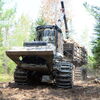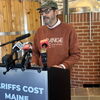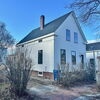
Processing Your Payment
Please do not leave this page until complete. This can take a few moments.
- News
-
Editions
-
- Lists
-
Viewpoints
-
Our Events
-
Event Info
- Women's Leadership Forum 2025
- On the Road with Mainebiz in Bethel
- Health Care Forum 2025
- On The Road with Mainebiz in Greenville
- On The Road with Mainebiz in Waterville
- Small Business Forum 2025
- Outstanding Women in Business Reception 2025
- On The Road with Mainebiz in Bath
- 60 Ideas in 60 Minutes Portland 2025
- 40 Under 40 Awards Reception 2025
- On The Road with Mainebiz in Lewiston / Auburn
- 60 Ideas in 60 Minutes Bangor 2025
Award Honorees
- 2025 Business Leaders of the Year
- 2024 Women to Watch Honorees
- 2024 Business Leaders of the Year
- 2023 NextUp: 40 Under 40 Honorees
- 2023 Women to Watch Honorees
- 2023 Business Leaders of the Year
- 2022 NextUp: 40 Under 40 Honorees
- 2022 Women to Watch Honorees
- 2022 Business Leaders of the Year
-
-
Calendar
-
Biz Marketplace
- News
- Editions
- Lists
- Viewpoints
-
Our Events
Event Info
- View all Events
- Women's Leadership Forum 2025
- On the Road with Mainebiz in Bethel
- Health Care Forum 2025
- On The Road with Mainebiz in Greenville
- On The Road with Mainebiz in Waterville
- + More
Award Honorees
- 2025 Business Leaders of the Year
- 2024 Women to Watch Honorees
- 2024 Business Leaders of the Year
- 2023 NextUp: 40 Under 40 Honorees
- 2023 Women to Watch Honorees
- 2023 Business Leaders of the Year
- + More
- 2022 NextUp: 40 Under 40 Honorees
- 2022 Women to Watch Honorees
- 2022 Business Leaders of the Year
- Nomination Forms
- Calendar
- Biz Marketplace
Wood 'that tells a story' is boon for growing Gardiner urban timber business
In the lower level of a 19th century mill in Gardiner, huge slabs of red oak and maple lean against the brick wall. On the other side of the room, Niles Krech pulls a cart stacked with 14 slabs of red oak and butternut from a large kiln.
"We don't go to the forest to get our trees," Krech said as he checked the moisture level. It'll take about a month for the slabs to reach the 8% that is needed for them to be made into tables, desks, counters and other features in homes and businesses.
"These are street trees, they would've been chipped and thrown out," he said.
Krech, who in his day job is an investigator for the state attorney general's office, and business partner Steve Pracher, a pharmacist, started Maine Urban Timber Co. almost on a whim last year after they built a sawmill "just to mess around."
Then Krech started reading up on urban trees and what happens to them once they're taken down, something that's becoming more common in Maine, with invasive species like emerald ash borer and increased development. Street trees, once they're cut down, are mostly chipped up and hauled to a landfill, where the city, town, arborist or developer pays a per-ton fee to dump the chips.
While some arborists and sawmills cut the trees up, most don't have a bandsaw big enough for the width of many of Maine's old maples and red oaks.
What would happen, Krech, a woodworker hobbyist, wondered, if those trees were made into something that could be used?
Two increasingly large hand-built sawmills and a building expansion later, he and Pracher have found out. Maine Urban Timber Co. is drying, levelling and selling as many slabs a month as their 13-by-5 foot iDry vacuum kiln can handle. They have a waiting list that stretches back months.
The company started in a 500-square-foot space in the multi-business former mill at 521 Water St. in Gardiner in October. They soon expanded to an adjacent 3,500-square-foot space.
Their largest sawmill can handle logs up to more than 7 feet long and 53 inches in diameter, much larger than the traditional 33-inch diameter sawmills. They also have a large grapple to remove logs from the site where they fell.
Krech believes the company is the only one in Maine that targets urban street trees that would othewise be bound for the chipper. While the finished product is mostly used for furnishings, he foresees a time soon when the company will expand to flooring and other building features.
That, however, will take another $60,000 kiln. In the meantime, Maine Urban Timber Co. sources trees from Portland and other cities and towns in the state that remove them because of disease or hazard, as well as arborists. The company pays pulpwood prices, about $40 a ton, which is less than most tipping costs to dispose of the chipped wood. The slabs sell for between $125 and $350, but it all depends on size and shape.

Wood that tells a story
The company also does special orders — for instance, a slab of a silver maple from the yard of a woman's childhood home in Skowhegan will be a 12-foot-long dining table.
Maine Urban Timber Co. also uses wood that most mills would discard. The knots, crotches and cracks that make for bad lumber make great tables and bar tops.
"We use wood that normally wouldn't be used," he said. "People like wood that tells a story."
That's a growing trend, said Lee Burnett, of Local Wood Works, which connects vendors in the state's timber industry to buyers, including artchitects and contractors.
"There's definitely a growing interest in wood with a story," Burnett said. "You can walk into bars all over Maine and see bar tops made from slabs, tables made from them."
He said that Maine Urban Timber Co. has found a niche. "It's not a big market, but it's a growing market," Burnett said.
Krech said the biggest issue is connecting with a supply. While he works with a number of arborists, it's tough to get cities and towns to understand that he can provide a service, one they'll get paid for.
Emerald ash borer is limited to southern Maine, but as the state's trees become more infested, with the beetles boring into trees and, eventually, killing them, ash tree disposal will become a bigger problem. "There's no plan," he said.
The focus on ash trees has made the urban street tree timber movement in general catch on with all kinds of trees that would normally end up in the chipper.
In other parts of the country where ash borer damage is more prevelant, the urban timber movement has taken more shape. Burnett said, for instance, that Michigan has a network of municipalities, arborists, sawmills and manufacturers that repurpose street trees into slabs, flooring, even wooden bicycles.
Burnett said in general, companies that make good use of large slabs contribute to good forestry. Landowners who manage their forests know that letting trees grow to maturity means a healthier forest, but they don't get much more money for a 100-year-old tree than a 60-year-old one. And mills, for the most part, are cutting the wood into small pieces.
Maine Urban Timber Co. also, on its homepage, keeps track of the other benefit of what the company does: the environmental one.
As of the end of May, they'd salvaged 17,879 total board feet, sequestered 84,033 pounds of carbon, and diverted 117,510 pounds of wood from the waste stream.
Krech said while the company has found a niche, he sees it as a growing industry at the interersection of growing care for natural resources, climate change, the local products trend and the home and business remodeling that comes with the hot real estate market.
"There are so many upsides to it," he said.










0 Comments